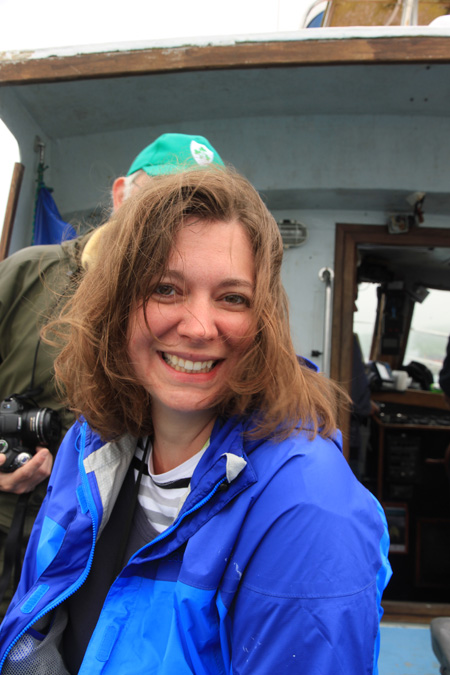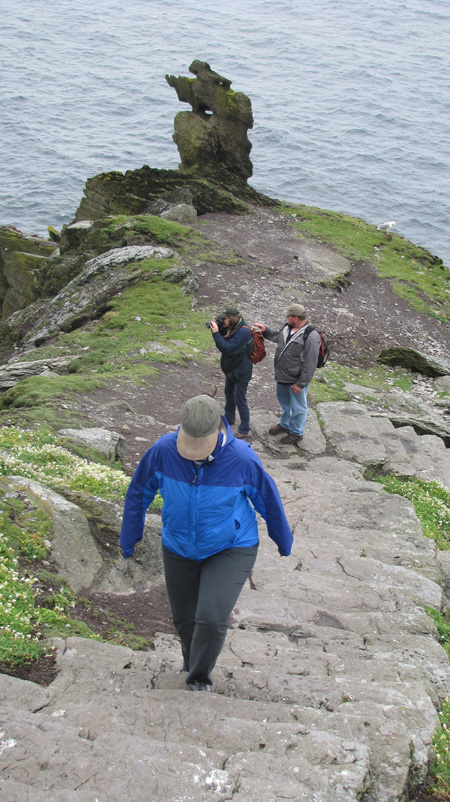Tuesday, July 31, 2012
Gallarus Oratory ~ Dingle Peninsula
The Gallaras Oratory, build about A.D. 800, is a sightseeing highlight as we traveled around the Dingle Peninsula. One of Ireland's best-preserved early Christian churches, its shape is reminiscent of an upturned boat. Its watertight dry-stone walls have sheltered travelers and pilgrims for 1,200 years. It is also said the oratory has never had a need to be restored. It is today what is was back then in all its glory.
As we were just about to leave the sun shown through a break in the clouds and illuminated the area in a warm glow.
Monday, July 30, 2012
Dingle Peninsula
There were many stone houses like the one above, they are famine houses. House that were abandoned during the potato famine of 1845-1852. These places no longer have the thatch roofs and are just empty reminders of the two million people that died or emigrated out of Ireland.
In 1844, a new form of potato blight was identified in America. It basically turned a potato into a mushy mess that was completely inedible. The American blight was first identified in France and the Isle of Wight in 1845. The summer of 1845 was mild but very wet in Britain. It was almost the perfect weather conditions for the blight to spread. The blight is still with us and is called ‘Phytophthora Infestans’ – an air carried fungus.
Between 1846 and 1850, the population of Ireland dropped by two million which represented 25% of the total population at the time. One million died of starvation or the diseases associated with the famine and one million emigrated to North America or parts of England.
On the high hillsides you can still see the rows where the potatoes rotted in the fields. These fields have been untouched since 1845.
Sunday, July 29, 2012
Slea Head ~ Dingle Peninsula
Slea Head Dingle Peninsula is the Western
most point in Europe closest to America.
Looking back over our shoulder to the
Ring of Kerry and Iveragh Peninsula.
"Hey look we were over there ~ and now ~ we are over here!"
"There is even sheep poop down there!"
Saturday, July 28, 2012
Dun Beag Promontory Fort - Dingle Peninsula
Exploring yet another early A.D. ring fort in a farmers sheep field. The sea has taken out part of the edge of Dun Beag but it is for the most part all still standing. You might be wondering how did so much history and these ring forts survive throughout the centuries and the explanation is simply because of superstitious beliefs that they were fairy forts. Thus over the years they were left alone and just became part of the landscape.
Friday, July 27, 2012
Skellig Michael ~ Hike Down
It was an amazing view at the top even through the mist and fog. The lives that the monks lead was tough and peaceful at the same time and I can see the attraction to this type of solitary life praying to God and finding inner peace.
The hike down was not so peaceful. Going up for me was easy and tough on my husband and it was just the opposite on the way down. Man was it tough for me and one step at a time for sure. Josh had an easier time going down and was there to catch me if I needed help. Just goes to show that we are such a good team!
On the boat ride back they took us past Little Skellig Michael Island. This is a true bird sanctuary home of some 27,000 pairs of gannets – the second largest colony of such seabirds in the world. It was remarkable watching all those birds nesting and flying around. A noisy and smelly island and the eggs had not even hatched yet. We also spotted a gray seal resting on a flat rock outcropping and as each wave came up to splash his head he would look up all annoyed, like the wave was disturbing his rest.
The boat ride back was much claimer and we enjoyed the ride and talking about the mystery and wonder that is Skellig Michael! A must do if you are ever in that area of the world.
Docks at Portmagee Ireland.
The boat we were on is the one at the far right.
Thursday, July 26, 2012
Skellig Michael ~ The Top
The hike up all those steps was very rewarding and worth every moment it took to take the steps one at times, one slow step at a time. These bee hive huts were build by Christian Monks 600-900 A.D. while they eked out a solitary life on the island praying and giving solace to God. They are the dry stone type of construction that I talked about before only stacked up to form a roof to keep the weather out.
They lived here for many 100 years, growing a garden, fishing and even had cows for milk up here which I imagine they brought up as a young calves. They lived and many died on the island and their cemetery can be seen in one of the above photos.
Truly an awesome place ~ trip of a lifetime!
Wednesday, July 25, 2012
Skellig Michael ~ Puffins
Thought I would add in a seagull photo too.
Skellig Michael is a bird sanctuary for these little fellas and a few other birds species as well. In May and June the Puffins are nesting on the island and on this day since it was cloudy and foggy there were more puffins hanging out on the island. If it would have been a nicer day they would have been out to sea fishing.
There were a few that we spotted coming onto shore with a beak full of fish and then they would dart into the burrow to feed the young'in so I was not able to get a good photo of them with a beak full of fish.
Watching these birds take off and fly is just amazing. It is like they have to jump off the clifff and flap their little stubby wings as hard and fast as they can to propel their little bodies into the air and fly. It was truly an amazing sight to see.
Puffins are just so cute. Don't you just want to squeezes them they are so cute?
Rule no 8: Thou shall not squeeze the puffins!
Tuesday, July 24, 2012
Skellig Michael ~ The Hike Up
Little Skellig Michael Island
600 uneven stone steps to the top! Good thing there were plenty of birds to distract me from looking down or too far ahead. It was a crazy hike to the top.
Monday, July 23, 2012
Skellig Michael ~ The Boat Ride
As you can see by the photos above the boat ride out to the island of Skellig Michael was a fun one. It was like riding a roller coaster which normally is not my thing but I was determined not to get sea sick. The four of us were all fine but the French tourists on our boat were not ~ icky. The boat ride was just over an hour long if I remember correctly.
Then out of the mist an island appears with the sound of birds and the waves against the rocks filling the air. Having it be misty and foggy was perfect to add to the mystery of the island.
It was a bit of a hike up the slippery stone walkway before we even got to the start of the 600 stone steps that you have to climb to get to the old monk settlement at the top.
Subscribe to:
Comments (Atom)





















































